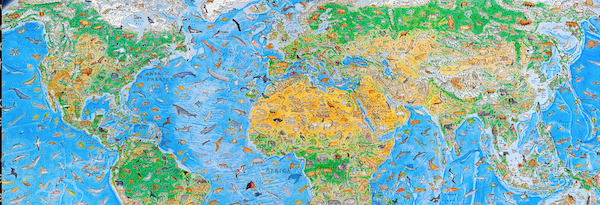|
Hand-drawn World Map Has 1,642 Animals, No National Borders
December 11, 2023
A cartographer has drawn a world map without national boundaries, focusing on wildlife. Anton Thomas, who was born in New Zealand and now lives in Australia, spent a total of 2,602 working hours during three years–starting during a COVID-caused lockdown–making the map, which he drew by hand, using a microscope at times to help with the detail. It was an interesting exercise, he said, in self-determination. The wildlife couldn't speak for itself, so he made the decision to place illustrations of wildlife where they were in their native locations and not to include any extinct species. In all, they total 1,642. For place names, he did extensive research and ended up using the names that the people who lived there called them. Nowhere are border of nations, states, or other political entities. Thomas said he wanted to focus on the natural landscapes, not what people have done to them. Significantly, the view on display is not what most people might deem the most familiar depiction of the earth's landmasses and waterways. Thomas has used the Natural Earth projection, a relatively new way to see the Earth, which has its center point 11 degrees of the Greenwich Meridian. Tom Patterson crafted the Natural Earth project in 2007 using a software program called Flex Projector. The result looks more like an elongated globe than does the Mercator Projection, still the most popular map form used today. Thomas is a self-trained artist who came late to cartography, even though maps captivated him from when he was very young. The inspiration for his latest work was a map of North America, which he had just finished when the COVID-19 pandemic struck, in July 2020. With much time on his hands, he began on his new work, which he eventually titled "Wild World." The rest is (natural) history. |
Social Studies for Kids |
Social Studies for Kids
copyright 2002–2024
David White






